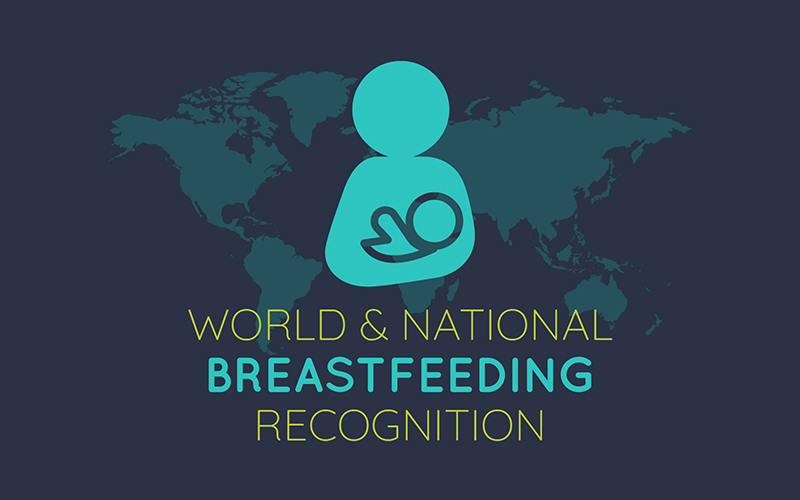
By Sarah Davis, Supervisor, Kent Clinic
The fight for health equity begins at day one and includes one of the most basic building blocks of life, feeding. While the act of feeding one’s baby is often mistakenly perceived as simple, breastfeeding/chestfeeding is a great feat. Research strongly supports the act of breastfeeding, which provides benefits to baby, as well as mothers and birthing people. The American Academy of Pediatrics (AAP) recommends infants exclusively breastfeed for about the first six months—evidence supports increased protection against some short- and long-term illnesses and diseases. Studies show that breastfed babies have lower rates of obesity, type 1 and 2 diabetes, lower risk for asthma and sudden infant death syndrome (SIDS). Birthing and breastfeeding people have benefits as well, including reduction in the risk of breast and ovarian cancer, type 2 diabetes, and high blood pressure, as well as an opportunity to share an intimate moment with your little one.
Initiation Rates
Feeding babies looks different to every person and we acknowledge that breastfeeding is not accessible to all for various reasons. It is not always the most glamorous or comfortable activity; however, it is a foundational tool to healthy generations. But does everyone have equitable access to this life-changing activity? Unfortunately not. Though breastfeeding rates have increased in the past decade, persistent disparities exist, particularly regarding race/ethnic background. The U.S. has one of the lowest breastfeeding initiation rates among industrialized nations. According to the Centers for Disease Control, “the prevalence of breastfeeding initiation was 84.1% overall and varied by maternal race/ethnicity, ranging from 90.3% among infants of Asian mothers to 73.6% among infants of Black mothers, a difference of 16.7%” (CDC, 2021). American Indian/Alaska Native (AI/AN) mothers have similar rates of breastfeeding initiation at 74%. Unfortunately, 76% of AI/AN breastfeeding people stopped within four months of the child’s birth. However, AI/AN mothers who continued to breastfeed through 6 months were more likely to continue breastfeeding through 12 months. An estimated 77% of Latinx breastfeeding people initiate breastfeeding; however, at six months after birth, roughly only 21% have continued breastfeeding.
Barriers
There are many possible factors impacting breastfeeding and include much more than whether or not the person chooses to breastfeed their child. Unsupportive cultural and social norms, insufficient education and childcare environments have been noted as barriers. In a study released in 2019, the disparities that affect Black breastfeeding populations were highlighted and included these barriers to successful breastfeeding: lack of support and guidance in latching and sustaining breastfeeding; the need to return to work earlier than 12 weeks; and inflexible work hours/policies once returning to work. The U.S. is the only developed country without laws that mandate paid parental leave. Kimberly Seals Allers, author of The Big Letdown, writes “Unfortunately, many communities of color have ‘desert-like’ conditions when it comes to breastfeeding support and resources.”
Trauma
Systemic racism and psychological trauma negatively impact breastfeeding rates in communities of color. Historical trauma such as Black mothers, during and after slavery, being forced to act as “wet nurses,” breastfeeding white children, rather than their own, is believed to have influenced lower rates of breastfeeding in Black populations. In addition, the publicized push that formula provided superior nutrition to infants depicted a false narrative that continues to influence birthing people today. Black mothers are twice as likely to receive in-hospital formula introduction than white mothers. American Natives suffered loss of culture and assimilation. The forced relocation of American Native children from their families and homes disconnected them from their traditions and elder support, including breastfeeding.
How Valley Supports Breastfeeding
Valley Medical Center is at the forefront to make lasting and impactful differences in the lives of the families that birth and seek perinatal care here. Taking the necessary steps to provide individualized perinatal care and support to each family directly impacts the trajectory of the health of our community. Through our supportive services, such as lactation services, midwives, and obstetricians, Valley is working to support our patients to achieve their infant feeding goals. Our diverse community, and family, also consists of our colleagues. Recent policy updates, such as the Infant-Friendly Feeding Support for Employees, encourage and support breastfeeding and pumping breaks throughout shifts to hopefully reduce the risk of work interfering with breastfeeding goals.
Honoring and celebrating National Breastfeeding Awareness Month is pivotal in spreading knowledge, advancing advocacy, and promoting breastfeeding to reduce inequities and ensure all families have an opportunity to breastfeed. Each person and population have their own story, each beautiful and enlightening.

